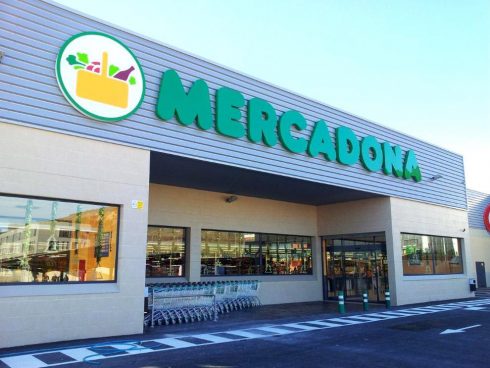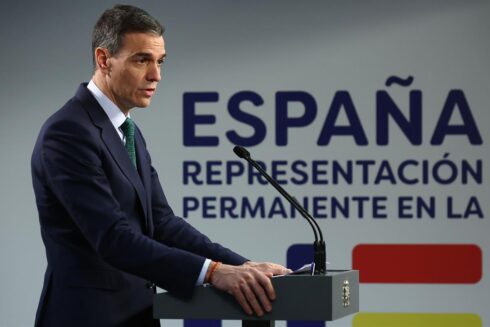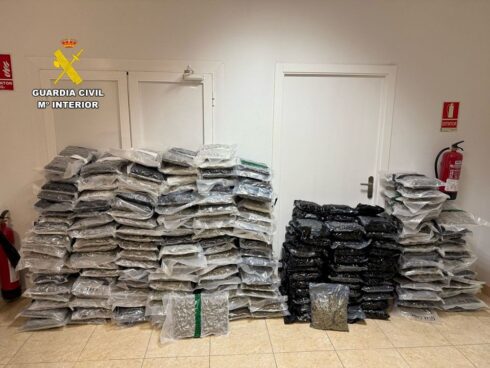By Wendy Williams and Jon Clarke
IT is one of the most controversial developments in Andalucian history and for many has become synonymous with corruption and greed.
Carved out of virgin woodland in stunning mountain scenery close to Ronda, developers behind the Los Merinos golf scheme became infamous around the world.
Ignoring protection orders to pull up thousands of ancient oak trees, they were also accused of ‘mafia’ tactics in the way they dealt with any opposition.
Indeed anyone who dared to stand up and criticise the double golf course project – with three luxury hotels and 800 houses built on UNESCO-protected land near Ronda – risked ending up in court.
In total, over 12 opponents – including a trio of expatriates – were landed with lengthy and costly legal battles for daring to oppose it.
But now a new book proves that they were almost certainly right to stand up.
The two-year study by Malaga University’s Department of Criminology concludes that the scheme was most certainly set up illegally.
It reveals that the project managed to circumvent the law using large amounts of money and through a string of secretive societies – around 50 in total.
“The book is a true gift from the Three Kings,” Juan Terroba from Ecologistas en Acción told the Olive Press.
“We hope this incredibly detailed and critical study will finally lead to the end of the project. The authorities must continue to stand up to it.”
By following the money trail, the researchers have managed to locate the key individuals behind the string of faceless companies.
Most interesting of all, they have revealed that one of Europe’s biggest fraudsters is the lynchpin behind the project.
Indeed, it has emerged that secretive foreign financier Werner Kurt Rey, from Switzerland, was the catalyst for the scheme, which was first mooted in the 1980s.
But, as the book shows, he was anything but the only big name involved, with others including the brother of former EU boss Javier Solana, as well as the Junta de Andalucia’s former planning svengali Jaime Montaner.
The Los Merinos story is ultimately a long and complicated one, but what researchers are now certain of is that the idea was first hatched back in the 1980s.
Seeing the project as a fabulous way to make a killing during the property boom, a group of foreign investors got the ball rolling.
Appropriately set up in the secretive tax haven of Liechtenstein, The Golf and Country Club Ronda was first created in 1987 by Swiss lawyer Walter Neupert Dietrich.
But while Dietrich was the frontman, it was Swiss entrepreneur Rey, who put up the capital.
Dubbed in his country as ‘something of a financial acrobat’, the billionaire shot to fame when he emerged from nowhere as the majority shareholder in the shoe company Bally.
With hundreds of shops in the UK and around Europe it was a huge money-making operation and throughout the eighties Rey seemed to have the Midas touch with everything he touched turning to gold.
He sold the company in a multi-million euro deal in 1988 and started a series of new, but more risky enterprises, a number of them in Eastern Europe following the fall of the wall.
Eventually however the Zurich-born former bank clerk took one risk too many and lost everything, owing money to everyone and becoming implicated in the largest corporate fraud in Swiss history.
It happened almost in the same month he was listed in Forbes magazine in 1990 as being among the world’s richest men.
Credited as being worth a billion dollars, it came as something of a shock to many when his business empire Omni AG suddenly collapsed leaving two billion euros of debt.
It caused shockwaves around Switzerland and Rey was accused of embezzlement and fraud. But Rey wasn’t ready for prison and, perhaps predictably, in 1991 fled to the Bahamas, where he was to hide for the next seven years.
But not before he had managed to acquire eight million square metres of land near Ronda from Antonio Martin Criado, the then President of Malaga Chamber of Commerce.
From then on, there was a ten-year hiatus in proceedings of the planned golf course development, largely it is believed because Rey was abroad.
But he was not having everything his way. After a long search, Interpol tracked him down to the Bahamas, where he was put in prison for two years while awaiting extradition.
He was finally brought back to Switzerland under an international arrest warrant in 1998 and spent a further two years in prison.
Meanwhile in the interim years Ronda town hall conveniently had the huge area – which had been awarded ‘special protection status’ in 1987 – re-zoned.
In 1994 the area, known as Los Merinos, was made urbanizable for certain large scale tourist projects.
It is unknown at what point Rey stopped being involved with the project.But when he was finally released in 2000, he promptly went off the radar and his current whereabouts are unknown.
What is known however, is that in October 2001 his colleague, Dietrich, placed an advert in national newspaper El Pais looking for new investors in the now long-dormant project.
And this is when the story gets complicated, for over the last 10 years a total of up to 50 different companies have arrived on the scene each with a confusing number of shareholders.
But the researchers José Luis Díez Ripoll, Alejandra Gómez Céspedes and Araceli Aguilar Conde insist this is the modus operandi of the development: the dense maze of companies serving to mask what is really going on and who is responsible.
“This is an effective mechanism hiding he true goals of the company and who is involved,” explains Gomez, who previously helped to uncover the moneytrail in the current Malaya trial in Marbella. “It makes it very difficult to hold anyone responsible.”
Through painstaking research however, the team managed to find a small core of names that kept turning up again and again.
“It helped us unravel the real objectives being pursued and the protagonists behind the scheme,” continues Gómez.
What is absolutely certain is the current involvement of the Copisa Group, one of the 20 largest construction companies in Spain.
Insisting that the project is now completely legal and has all the environmental requirements, it sits alongside various other companies Ibex 35, Fomento de Construcciones y Contratas (FCC) and the Agbar Group.
The researchers also pinpointed a number of key individuals involved in the scheme.
In particular, they highlighted the role of former Junta Public Works Minister Jaime Montaner.
First involved as a political figure in the 1990s, he later emerged – surprise, surprise – as one of the key private players involved in the development.
Indeed, it was Montaner in his powerful position in the Junta, who helped to ensure that the 1994 PGOU town plan of Ronda was accepted and signed off.
Then a decade later he emerged as one of the key employees and apparent investors in the scheme.
Another key figure is Socialist leader Luis Solana, ex-director of Telefónica and RTVE and brother of former EU minister Javier Solana.
And, of course, mayor of Ronda, Antonio Marín Lara, was notably charged with corruption, after allowing the scheme to continue when it still hadn’t met environmental criteria, particularly over the use of water.
It is these environmental issues that to this day still stand to condemn the development.
For despite failing to get all the necessary permits, work began on the scheme five years ago, starting with the pulling up of thousands of ancient oak trees to make way for roads, sewerage and other infrastructure.
It led to mass protests against the scheme and clamour from both the national and international press – in particular the Times and Independent – about it.
An army of pressure groups, including Greenpeace and Ecologistas en Accion, campaigned against it, while the entire neighbouring village of Cuevas del Becerro held a ‘general strike’ over fear for their water supply.
The European Union even stepped in to investigate – slamming the behaviour of the developers – and bird groups found that numerous protected species, including the rare Bonelli’s eagle, were being endangered.
The Olive Press reported on the project from its very first issue in November 2006, pointing out how the developers had blocked off public footpaths, including the international GR-7 path from Tarifa to Greece.
Alarmingly, it emerged, that three people who criticised the scheme in the paper, found themselves subject to legal ‘mafia tactics’.
The trio, including Alastair Boyd – aka Lord Kilmarnock – were sued by the developers for a total of 22 million euros for publicly criticising it.
And although the case was eventually thrown out of court on the basis of freedom of speech it took two years for this to happen.
Boyd sadly died in 2009 with friends blaming the stress of the lawsuit for the deterioration in his health.
The trio had merely signed a petition and dared to call the scheme “unsustainable” in print.
But, the latest research shows that there was a lot more than just environmental abuse going on.
According to the new book numerous ‘irregularities’ took place suggesting much has been achieved through the back door.
In particular, the book highlights how Ronda town hall used its planning department to suit itself, with some ‘essential administrative steps’ being ignored and decisions being ‘inconsistent if not contradictory’.
For example, the PGOU General Urban Plan adopted in 1994 declared Los Merinos to be ‘developable land’.
This required an amendment to the Special Protection Plan that had been previously approved in 1987, but the documents published 20 years later, in 2007, did not include the change.
As researcher Gómez explains: “The infinite flexibility of the administrative procedure, must certainly question its legality.”
In particular, the book showed the extent to which the town hall went to aid developers.
For example, when the scheme was refused permission to take water from underground aquifers, the mayor swiftly made an agreement to construct a water pipeline all the way to the development some 20 kilometres away.
Moreover, the promoters of the plan were shown to have had ‘an enormous influence’ on the local politicians.
On top of this, there was an ‘intensive use of legal tools’ to get their way.
Ultimately though, it was the recession that apparently got the better of the developers.
In 2008, the Los Merinos project stopped all work for “at least a year” with developers admitting a combination of the world economic situation; the property crisis and a lack of the correct licences being behind the halt.
Local sources told the Olive Press at the time however, that a shortage of buyers, perhaps due to its controversy, had played a large part.
“This is a fantastic victory for all the brave locals who have fought tirelessly to stop it,” Isabel Teresa Rosado, former mayor of Cuevas del Becerro, said at the time. There is one huge fly in the ointment though.
And it is the small issue of 11.5 million euros out of an agreed 18 million euros that has been paid to Ronda town hall for licences for the scheme.
With the most recent payment coming just last month, it shows the developers have no intention of giving up.
But then again, nor have the protesters given up, as the most recent demonstration against the cutting off of footpaths showed this weekend.
Over 100 hardy souls gathered in icy temperatures to once again demonstrate against the macroproject that still scars the beautiful landscape alongside the Sierra de las Nieves natural park.
With both sides vowing to fight on the never-ending saga could end up taking three decades to conclude.
But whatever the outcome, it is now quite clear that the developers will have got their way using a number of underhand – even illegal tactics – to carve up a once beautiful virgin area.
In this tale of corruption and greed, perhaps the only winners are the lawyers.











You appear to have missed out the Jewish-Zionist link in the whole tale. So much for doing “research” on this macro-project. The idea for them was to create a safe haven for the day Israel sinks. Dare to investigate that!
Ron – please contact jon@theolivepress.es urgently please.
Who cares about the religion of who has done this? The real travesty is that Spain allowed it to happen. As I said before, and again now, Spain could not give a XXXX about UNESCO biospheres.
Good story. Ron you are an idiot.
hi ron,
perhaps you have some information you could shed on this…. you clearly know something.
jon
(editor)
Exscuse me, Ron, ‘The day Israel sinks’? And the solution is a couple of golfcourses in Ronda? Sorry, I don’t buy it.
Haha – can’t you tell that Ron is having a laugh?
Perhaps you should lay off the Rioja a bit.
lol
Nice one OP. Keep up the good work/investigative journalism.
If Ron was having a laugh, fine. But after 1001 nights of TRE FM about the Bilderberg, 9/11, Kennedy, Illuminati, Princess Di, David Icke etc etc, ad nauseum….. One gets the impression that a few of us have indeed lost the plot.
I thought the safe haven was already established on Long Island.
The book aims at delivering a lot of impressive research and facts, yet diverting all attention to a mystery man by using a high proportion of unverified and speculative information.
The authors’ suspicion is based on a single suggestion in an article in the Swiss media in 1994 and the presented fact that a law firm was involved in the deal, who only years later was joined by one of Rey’s trustees.
It is therefore inconceivable how the academic authors would credibly justify their many pages of descriptions on Rey as copied directly from unchecked entries in Wikipedia, and which do not even contribute in any way to the suggested claims.